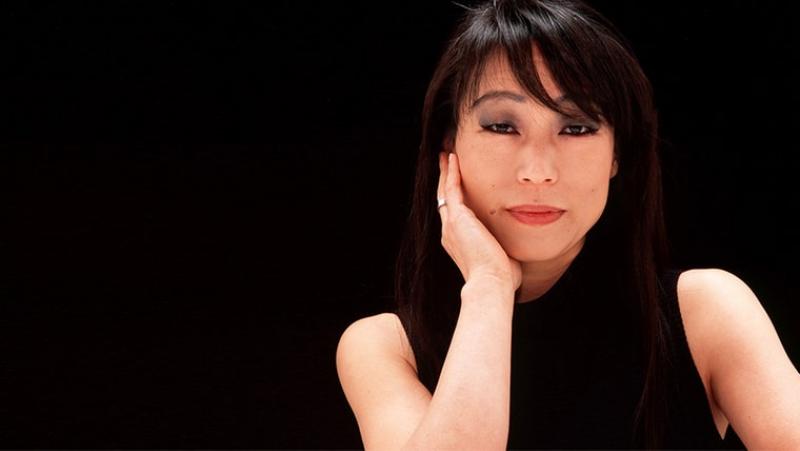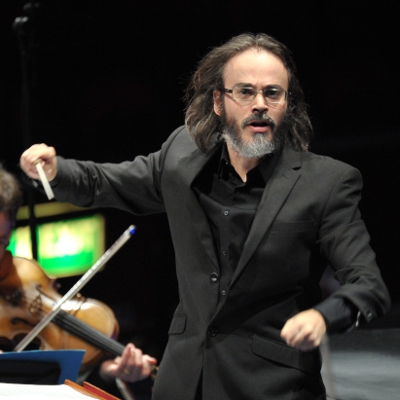10 Questions for Composer Unsuk Chin | reviews, news & interviews
10 Questions for Composer Unsuk Chin
10 Questions for Composer Unsuk Chin
Introducing her latest work, inspired by dance, but also by tales of sinister obsessions with artificial life

There is no mistaking the music of Unsuk Chin. Born in Korea and based in Berlin, Chin brings a range of cultural perspectives to her work. She often describes her music in terms of light and colour, and evokes dreamscapes when recalling her inspirations. Yet her music also has a strong gestural quality, her musical ideas are clear and definite, often subtle but never ambiguous.
It is an approach that has won her many admirers and advocates, among them some of classical music’s biggest names, including Simon Rattle, Esa-Pekka Salonen and Gustavo Dudamel. And she has received numerous awards, most notably the Grawemeyer in 2004, often described as the Nobel Prize of classical music.
UK audiences have had several opportunities to hear her music in recent years. Her Cello Concerto was premiered at the BBC Proms in 2010 by Alban Gerhardt, followed in the 2014 season by a performance of Šu, her concerto for sheng (the traditional Chinese mouth organ) and orchestra given by soloist Wu Wei and the Seoul Philharmonic. In 2011, the BBC Symphony Orchestra organised a full day of concerts devoted to Chin’s music, showcasing the vast array of influences and ideas that have contributed to her music over the last two decades.
Unsuk Chin has had a particularly high profile this year as a result of her first opera, Alice in Wonderland. The piece dates back to 2007, but a new multimedia staging of the opera by Netia Jones toured to several cities around the world, and played to a capacity audience in London.
 Dance is at the heart of her latest piece, little wonder perhaps, given the focus on gesture and movement in all her music. The work, entitled Mannequin, has been commissioned by the National Youth Orchestra of Great Britain. They will be giving the premiere on 9 April in Gateshead, in a concert led by the enterprising young Israeli conductor Ilan Volkov (pictured left).
Dance is at the heart of her latest piece, little wonder perhaps, given the focus on gesture and movement in all her music. The work, entitled Mannequin, has been commissioned by the National Youth Orchestra of Great Britain. They will be giving the premiere on 9 April in Gateshead, in a concert led by the enterprising young Israeli conductor Ilan Volkov (pictured left).
GAVIN DIXON Can you explain the title of Mannequin?
UNSUK CHIN It started with two short stories by Bruno Schulz named “Mannequins“ and “Treatise on Mannequins” – however, only the title remained, my work has otherwise nothing to do with Bruno Schulz, but instead draws on 19th-century writer and polymath E. T. A. Hoffmann’s short story “The Sandman.” The title of my piece can be understood as an allegory since the main character of Hoffmann’s tale is torn between hallucinations and reality (as is the whole story which could be seen as an early example of magical realism), and since he feels himself controlled by a number of macabre “puppet masters”. The story also reflects Hoffmann’s obsession about artificial life, as exemplified in the third movement of my work “Dance of the Clockwork Girl” in which the main character falls in love with a life-size female robot. The fourth movement “The Stolen Eyes” is about the grotesque eye leitmotif that runs throughout Hoffmann’s tale and which also takes on an allegorical meaning.
A musical retelling, then, of Hoffmann’s tale?
What is especially interesting about Hoffmann’s story is that it is impossible to give an exhaustive interpretation of it since there are many false leads and many different levels of perception: reading it could be likened to a very complex police investigation – there are many pieces of evidence but a number of the clues don’t lead anywhere and it is a matter of opinion as to which of them are relevant in the end.
How has dance inspired the work?
My work is an “imaginary choreography”, it is highly gestural music and is strongly influenced by dance: I tried to create the feeling of weightlessness by means of breakneck virtuosity, timbral “smoke and mirrors” and other musical mirages and puzzles. That fantastical and deceptive aspect of art which attempts to try to defy physical laws, trying to make the impossible appear possible, is for me one of its essences. “All art is deception, and so is nature” (Vladimir Nabokov).
Could it be choreographed?
I very much hope that it will!
Have you worked with young performers before?
Yes, a couple of times. Last year, a new work of mine (Le silence des Sirènes, which was written for [soprano] Barbara Hannigan) was premiered by the Lucerne Festival Academy Orchestra under the baton of Simon Rattle. And a number of excellent soloists who have performed my concertos or my Piano Études were fairly young when they started to perform my music. As for teenage musicians, I once had a longer project with the National Youth Orchestra of the Netherlands, which was a great experience, too.
Are there any particular challenges or opportunities involved?
Each time, I have been thrilled by their energy, open-mindedness and commitment. I also love the workshop atmosphere of such projects: there is lots of rehearsal time available, so, it’s a kind of a "sanctuary" as opposed to the sometimes rigid structures on the mainstream concert circuit.
Have you worked before with Ilan Volkov?
Ilan is absolutely among my favourite conductors. The combination of high-voltage energy and utter precision that he brings into the creation of a new piece is exceptional. We have worked together many times. Ilan also conducted the premiere of my Cello Concerto at the BBC Proms.
Do you and he have any future collaborations planned?
Yes, I have invited him to conduct at my concert series in Seoul.
What was your reaction to the recent multi-media staging of Alice in Wonderland?
Netia Jones’s multi-media staging was excellent, teeming with ideas and providing new insight into the work.
How did it compare to the first production?
So far, there have been five different productions of my opera. As for Achim Freyer’s premiere staging, it was intriguing, too. Though I disagreed with many of Freyer’s decisions – he treated the libretto and my stage directions as a sort of blueprint from which the final result differed very much – his ideas and images were absolutely unforgettable and fascinating.
- Mannequin premiered by the National Youth Orchestra of Great Britain at the Sage, Gateshead on 9 April, with further performances at Victoria Hall, Stoke-on-Trent on 10 April and the Royal Festival Hall on 11 April
Explore topics
Share this article
more Classical music
 First Person: Leeds Lieder Festival director and pianist Joseph Middleton on a beloved organisation back from the brink
Arts Council funding restored after the blow of 2023, new paths are being forged
First Person: Leeds Lieder Festival director and pianist Joseph Middleton on a beloved organisation back from the brink
Arts Council funding restored after the blow of 2023, new paths are being forged
 Classical CDs: Nymphs, magots and buckgoats
Epic symphonies, popular music from 17th century London and an engrossing tribute to a great Spanish pianist
Classical CDs: Nymphs, magots and buckgoats
Epic symphonies, popular music from 17th century London and an engrossing tribute to a great Spanish pianist
 Sheku Kanneh-Mason, Philharmonia Chorus, RPO, Petrenko, RFH review - poetic cello, blazing chorus
Atmospheric Elgar and Weinberg, but Rachmaninov's 'The Bells' takes the palm
Sheku Kanneh-Mason, Philharmonia Chorus, RPO, Petrenko, RFH review - poetic cello, blazing chorus
Atmospheric Elgar and Weinberg, but Rachmaninov's 'The Bells' takes the palm
 Daphnis et Chloé, Tenebrae, LSO, Pappano, Barbican review - lighting up Ravel’s ‘choreographic symphony’
All details outstanding in the lavish canvas of a giant masterpiece
Daphnis et Chloé, Tenebrae, LSO, Pappano, Barbican review - lighting up Ravel’s ‘choreographic symphony’
All details outstanding in the lavish canvas of a giant masterpiece
 Goldscheider, Spence, Britten Sinfonia, Milton Court review - heroic evening songs and a jolly horn ramble
Direct, cheerful new concerto by Huw Watkins, but the programme didn’t quite cohere
Goldscheider, Spence, Britten Sinfonia, Milton Court review - heroic evening songs and a jolly horn ramble
Direct, cheerful new concerto by Huw Watkins, but the programme didn’t quite cohere
 Marwood, Power, Watkins, Hallé, Adès, Bridgewater Hall, Manchester review - sonic adventure and luxuriance
Premiere of a mesmeric piece from composer Oliver Leith
Marwood, Power, Watkins, Hallé, Adès, Bridgewater Hall, Manchester review - sonic adventure and luxuriance
Premiere of a mesmeric piece from composer Oliver Leith
 Elmore String Quartet, Kings Place review - impressive playing from an emerging group
A new work holds its own alongside acknowledged masterpieces
Elmore String Quartet, Kings Place review - impressive playing from an emerging group
A new work holds its own alongside acknowledged masterpieces
 Gilliver, LSO, Roth, Barbican review - the future is bright
Vivid engagement in fresh works by young British composers, and an orchestra on form
Gilliver, LSO, Roth, Barbican review - the future is bright
Vivid engagement in fresh works by young British composers, and an orchestra on form
 Josefowicz, LPO, Järvi, RFH review - friendly monsters
Mighty but accessible Bruckner from a peerless interpreter
Josefowicz, LPO, Järvi, RFH review - friendly monsters
Mighty but accessible Bruckner from a peerless interpreter
 Cargill, Kantos Chamber Choir, Manchester Camerata, Menezes, Stoller Hall, Manchester review - imagination and star quality
Choral-orchestral collaboration is set for great things
Cargill, Kantos Chamber Choir, Manchester Camerata, Menezes, Stoller Hall, Manchester review - imagination and star quality
Choral-orchestral collaboration is set for great things
 St Matthew Passion, Academy of Ancient Music, Cummings, Barbican review - moving and humble
A small-forces performance of intimacy and directness
St Matthew Passion, Academy of Ancient Music, Cummings, Barbican review - moving and humble
A small-forces performance of intimacy and directness
 Classical CDs: Fog, overdubs and broken glass
An Easter oratorio, plus late-romantic song transcriptions and an iconic ballet score
Classical CDs: Fog, overdubs and broken glass
An Easter oratorio, plus late-romantic song transcriptions and an iconic ballet score

Add comment